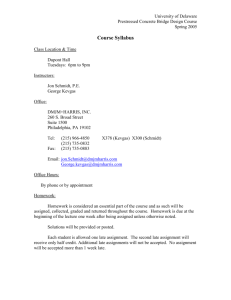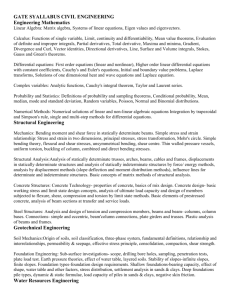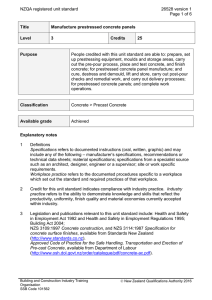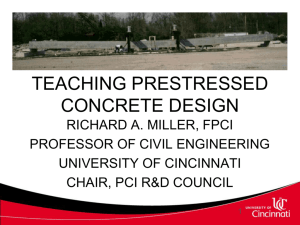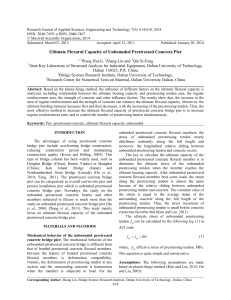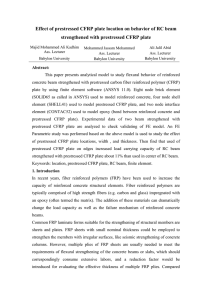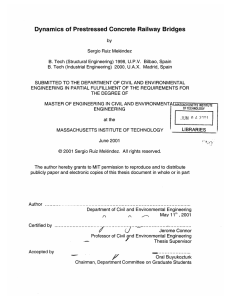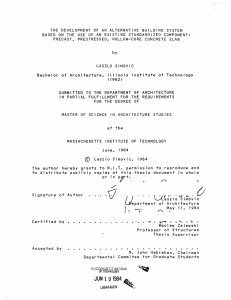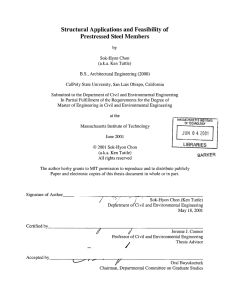bachelor of engineering – civil engineering
advertisement
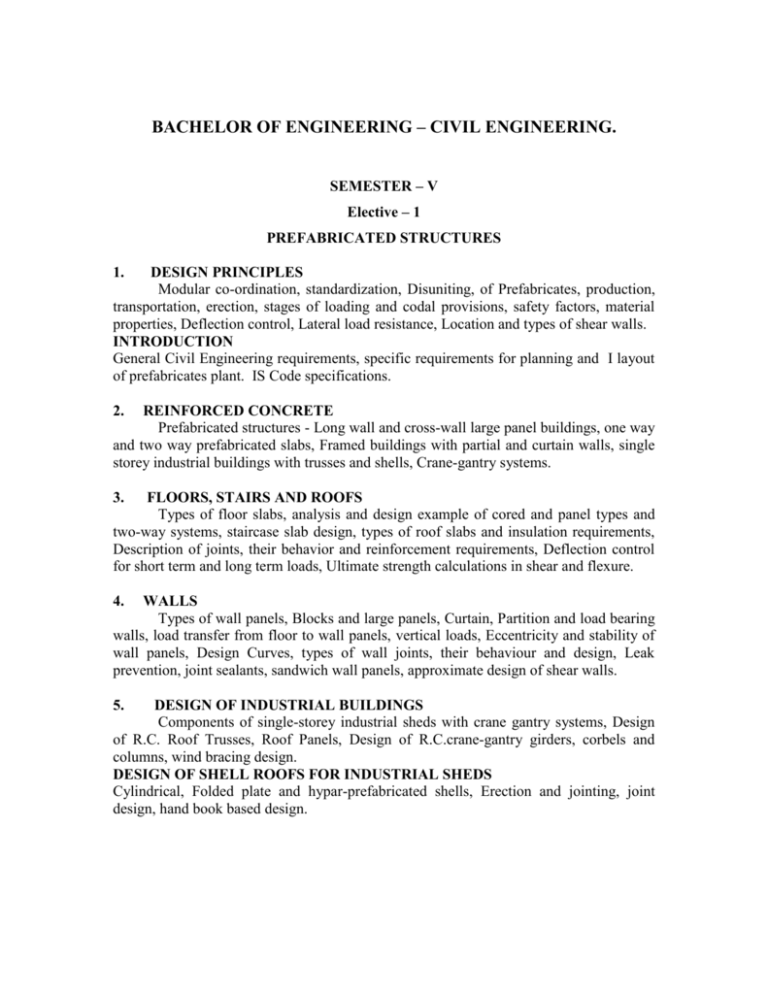
BACHELOR OF ENGINEERING – CIVIL ENGINEERING. SEMESTER – V Elective – 1 PREFABRICATED STRUCTURES 1. DESIGN PRINCIPLES Modular co-ordination, standardization, Disuniting, of Prefabricates, production, transportation, erection, stages of loading and codal provisions, safety factors, material properties, Deflection control, Lateral load resistance, Location and types of shear walls. INTRODUCTION General Civil Engineering requirements, specific requirements for planning and I layout of prefabricates plant. IS Code specifications. 2. REINFORCED CONCRETE Prefabricated structures - Long wall and cross-wall large panel buildings, one way and two way prefabricated slabs, Framed buildings with partial and curtain walls, single storey industrial buildings with trusses and shells, Crane-gantry systems. 3. FLOORS, STAIRS AND ROOFS Types of floor slabs, analysis and design example of cored and panel types and two-way systems, staircase slab design, types of roof slabs and insulation requirements, Description of joints, their behavior and reinforcement requirements, Deflection control for short term and long term loads, Ultimate strength calculations in shear and flexure. 4. WALLS Types of wall panels, Blocks and large panels, Curtain, Partition and load bearing walls, load transfer from floor to wall panels, vertical loads, Eccentricity and stability of wall panels, Design Curves, types of wall joints, their behaviour and design, Leak prevention, joint sealants, sandwich wall panels, approximate design of shear walls. 5. DESIGN OF INDUSTRIAL BUILDINGS Components of single-storey industrial sheds with crane gantry systems, Design of R.C. Roof Trusses, Roof Panels, Design of R.C.crane-gantry girders, corbels and columns, wind bracing design. DESIGN OF SHELL ROOFS FOR INDUSTRIAL SHEDS Cylindrical, Folded plate and hypar-prefabricated shells, Erection and jointing, joint design, hand book based design. References: 1. 2. 3. 4. 5. 6. 7. 8. B.Lewicki, Building with Large Prefabricates, Elsevier Publishing Company, Amsterdam/ London/ New York, 1966. Koncz.T., Manual of Precast Concrete Construction, Vol.I II and III, Bauverlag, GMBH, 1971. Structural Design Manual, Precast Concrete Connection Details, Society for the Studies in the use of Precase Concrete, Netherland Betor Verlag, 1978. Lasslo Mokk, Prefabricated Concrete for Industrial and Public Sectors, Akademiai Kiado, Budapest, 1964. Murashev.V., Sigalov.E., and Bailov.V., Design of Reinforced Concrete Structures, Mir Publishers, 1968. CBRI, Building Materials and Components, 1990, India. Gerostiza. C.Z., Hendrikson, C., Rehat D.R., Knowledge Based Process Planning for Construction and Manufacturing, Academic Press, Inc., 1989. Warszawski, A., Industrialization and Robotics in Building - A managerial approach, Harper & Row, 1990. SEMESTER – VI Elective – 2 PRESTRESSED CONCRETE 1. INTRODUCTION AND CODAL PROVISIONS Principles of Prestressing - types and systems of prestressing, need for High Strength materials, Analysis methods losses, deflection (short-long term), camber, cable layouts. Behaviour under flexure - codal provisions (IS, British ACI and DIN), ultimate strength. 2. DESIGN PRINCIPLES FOR FLEXURE SHEAR BOND AND END BLOCKS Design of flexural members, Design for Shear, bond and torsion. Design of End blocks and their importance Design of tension members - application in the design of prestressed pipes and prestressed concrete cylindrical water tanks. 3. DESIGN OF COMPRESSION MEMBERS Design of compression members with and without flexure - its application in the design piles, flagmasts and similar structures. COMPOSITE BEAMS Composite beams - analysis and design, ultimate strength - their applications. Partial prestressing - its advantages and applications. 4. CONTINUOUS BEAMS Application of prestressing in continuous beams, concept of linear transformation, concordant cable profile and cap cables. 5. DESIGN OF SPECIAL STRUCTURES Special structures like prestressed folded plates, prestressed cylindrical shells, prestressed concrete poles. Text Books: 1. 2. 1985. Prestressed Concrete by Krishna Raju, Tata McGraw Hill Publishing Co. 2nd Edition, 1988. Fundamentals of Prestressed Concrete by N.C.Sinha & S.K.Roy S.Chand & Co., References: 1. T.Y.Lin, Design of Prestressed Concrete Structures, John Wiley and Sons, Inc 1960. 2. Leonhardt.F., Prestressed Concrete, Design and Construction, Wilhelm Ernst and Shon, Berlin, 1964. 3. Freyssinet, Prestressed Concrete 4. Military Engineers Hand Book 5. Evans, R.H. and Bennett, E.W., Prestressed Concrete, Champman and Hall, London, 1958. SEMESTER – VIII Elective – 3 INDUSTRIAL WASTE MANAGEMENT 1. INTRODUCTION Industrial scenario - Uses of Water by industry - Sources and types of industrial wastewater - Industrial wastewater disposal and environmental impacts - Reasons for treatment of industrial wastewater - Regulatory requirements -Industrial waste survey Industrial wastewater generation rates, characterization and variables - Population equivalent - Toxicity of indu~trial effluents and Bioassay tests - Preventing and minimizing wastes at the source - Individual and Common Effluent Treatment Plants Joint treatment of industrial wastewater. 2. INDUSTRIAL. WASTEWATER TREATMENT Equalisation - Neutralisation - Oil separation - Flotation - Precipitation - Heavy metal Removal- Refractory organics separation by adsorption - Aerobic and anaerobic biological treatment - Sequencing batch reactors - High Rate reactors. 3. ADVANCED WASTEWATER TREATMENT AND REUSE Chemical oxidation - Ozonation - Photocat'alysis - Wet Air Oxidation Evaporation Ion Exchange - Membrane Technologies - Nutrient removal- Land Treatment. 4. RESIDUAL MANAGEMENT Residuals of industrial wastewater treatment - Quantification and characteristics of Sludge - Thickening, digestion, conditioning, dewatering and disposal of sludge Management of RO rejects. 5. CASE STUDIES Industrial manufacturing process description, wastewater characteristics and waste treatment flow sheet for Textiles - Tanneries - Pulp and paper - metal finishing Petroleum Refining - Chemical industries - Sugar and Distilleries - Dairy - Iron and steel fertilizers - Industrial clusters and Industrial Estates. Reference: 1. 2. 3. Eckenfelder, W W, (1999) 'Industrial Water Pollution Control',Mc-Graw Hill Arceivala, S.J., (1998) 'Wastewater Treatment for Pollution Control', Tata McGraw Hill. World Bank Group (1998) 'Pollution Prevention and Abatement Handbook – Towards Cleaner Production', World Bank and UNEp, Washington D.C. SEMESTER – VIII Elective – 4 AIR POLLUTION MANAGEMENT 1. INTRODUCTION Sources and classification of Air Pollutants: Natural contaminants-aerosol-gases and vapour. Air quality standards Meteorology and Air pollution: Atmospheric stability and inversions-mixing height-plume behavior-plume rise estimation - effluent dispersion theories-Isokinetic sampling- Modeling. 2. CONTROL OF PARTICULATES Objectives- Filters, gravitational, centrifugal-multiple type cyclones. prediction of collection efficiency, pressure drop; wet collectors, Electrostatic Precipitation theory-particle charging-particle collection-ESP design procedure 3. GASEOUS POLLUTANT CONTROL Absorption: principles, description of equipment-packed and plate columns, design and performance equations. Adsorption principal adsorbents, equipment descriptions-PSA-adsorption cycle-solvent recovery system-continuous rotary bed-fluidized bed, Design and performance equations. Condensation: contact condensers-shell and tube condensers, design and performance equation. Incineration :hydrocarbon incineration kinetics, equipment description, design and performance equations. 4. CONTROL MEASURES FOR INDUSTRIAL APPLICATIONS Control methods-Processes based control mechanisms-mineral products-asphaltic concrete, cement plants and glass manufacturing plants; Thermal power plants, Petroleum refining and storage plants, Fertilizers, Pharmaceuticals and wood processing industry. Field Study, 5. NOISE CONTROL: Noise Standards; measurement, control and preventive measures References: 1. 2. 3. Richard w. Boubel et al "Fundamentals of Air Pollution", Academic Press, New York, 1994 2. Noel de Nevers, Air Pollution control Engg., McGraw Hill, New York, 1995 M. N. Rao et aI, "Air Pollution" Tala McGraw Hill, 1989

